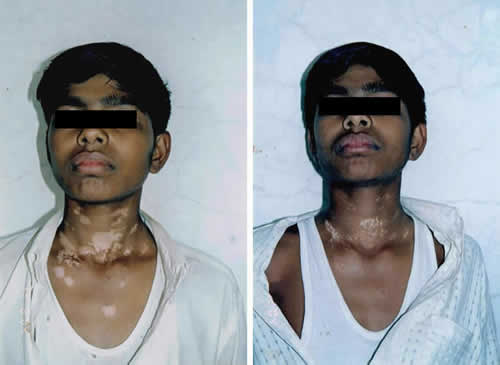Cervical spondylitis
Cervical spondylitis is a common regressive condition of the cervical (neck) spine that most probably is caused by factors associated with age changes (wear and tear) in the intervertebral disc and vertebrae of the neck. Research has shown that CSM (cervical spondylotic myelopathy) is the most common cause of non-traumatic weakness in limbs and a determined rigidity and troublesome pain in the neck.
Spondylo' is a Greek word that means vertebra. Spondylitis means changes in the vertebral joint illustrated by increasing deterioration of the intervertebral disc with successive changes in the bones and soft tissues.
Most often in people higher than the age of 40, the intervertebral discs get gradually dehydrated and they become more compressible and less elastic. Mineral deposition starts occurring in the intervertebral disc resulting in secondary changes. Though majority of individuals over 40 years of age demonstrate major radiological confirmation of the above changes, only a small percentage develop symptoms of the same. Another notable point is that sometimes the degenerative changes in the cervical spine can be visible on the X-ray as early as in 30’s however it does not call for any treatment if the patient is not symptomatic.
The above changes result in firmness of the nerves leading to radiculopathy (pain, numbness, weakness and loss of reflex due to compression and irritation of spinal nerve) or compression of the spinal cord resulting in cervical spondylotic myelopathy (CSM) (commonly caused by spinal stenosis resulting in loss of movements and sensation). Both the neural and spinal cord firmness will result in radiculomyelopathy.
Causes
Cervical spondylitis results due to unusual wear of the cartilage and bones of the neck (cervical vertebrae) with degeneration and mineral deposit in the cushions between the vertebrae (cervical disks). This is more common after the age of 40.
- Frequent occupational strain e.g., carrying loads on head, professional dancing, gymnastics can contribute.
- Tendency to development of cervical spondylitis has been reported in certain families; a genetic cause is probable.
- Smoking also can be a risk factor.
- Circumstances like congenitally fused spine, Down syndrome, cerebral palsy etc. may be risk factors for spondylotic disease.
- Doing work that demands minute concentration, people who continually work by bending their neck
- Computer professionals, bike users
- Travelers who travel a long distance and sleep in sitting position
- Telephone operators or individuals who repeatedly cradle the phone on the shoulder
- Practice of holding neck in one position, drivers who keep the neck in the same position for a long period of time, watching TV in abnormal positions or when lying down
- Old age people
Symptoms
Clinically, numerous groups of symptoms, both overlapping and distinct, are seen: neck and shoulder pain, headache and sub-occipital pain, radicular symptoms, and cervical spondylotic myelopathy (CSM).
The most common symptom is intermittent persistent neck and shoulder pain. The pain can be chronic or episodic, associated with long periods of remission.
- Neck pain is often accompanied by stiffness which increasingly worsens. Pain may also radiate to the shoulders or to the occiput. Many patients present with interscapular pain, pain in the arm, forearm, and/or hand pain.
- Non-specific headaches occurring mostly in the sub-occipital region (lower part at the back of head) and this pain radiates to the base of the neck and to the vertex (top) of the head.
- Patients without any history of trauma present with pain, loss of sensation, abnormal sensations and weakness, or a combination of these symptoms. These symptoms are often present in the shoulders, arms and rarely in the legs.
- Occasionally, the pain may be atypical and present as chest pain or breast pain (false angina).
- Patients with myelopathy can present with symptoms such as difficulty in writing; nonspecific, diffuse weakness; and abnormal sensations.
- Loss of sphincter control and urinary incontinence occurs in very rare cases, but some patients complain of urgency, frequency, and urinary hesitancy
On examination
The patient shows limited ability to bend the head to sides/front/back and to rotate the head.
- Stiffness of neck is the predominant sign, found in many of the patients.
- Weakness in muscles and altered sensations (in the affected areas as shown in the image above) are found in severe cases.
Homeopathic Treatment
Research confirmed homeopathic treatment offers incredible pain relief as well as better mobility for Cervical Spondylitis.
Dr Kabra's research based molecules which have international Patents. These New molecules have changed the entire homeopathic treatment protocol for the treatment of chronic painful conditions.
The Root Cause of Autoimmune Disease
It is our mission to provide each patient the best care in a kind, honest and compassionate manner.”











